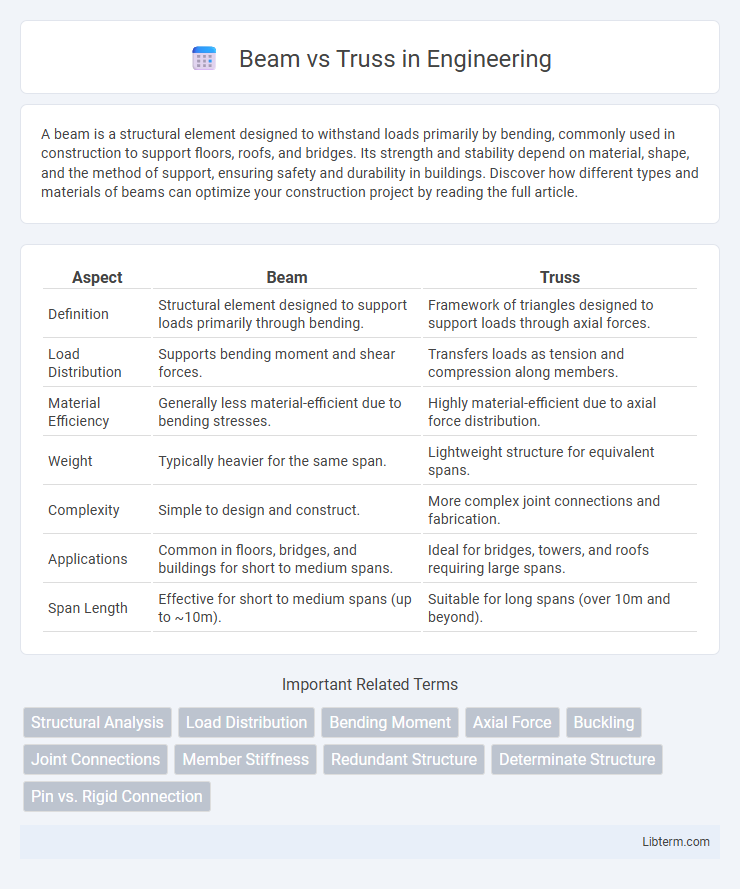A beam is a structural element designed to withstand loads primarily by bending, commonly used in construction to support floors, roofs, and bridges. Its strength and stability depend on material, shape, and the method of support, ensuring safety and durability in buildings. Discover how different types and materials of beams can optimize your construction project by reading the full article.
Table of Comparison
| Aspect | Beam | Truss |
|---|---|---|
| Definition | Structural element designed to support loads primarily through bending. | Framework of triangles designed to support loads through axial forces. |
| Load Distribution | Supports bending moment and shear forces. | Transfers loads as tension and compression along members. |
| Material Efficiency | Generally less material-efficient due to bending stresses. | Highly material-efficient due to axial force distribution. |
| Weight | Typically heavier for the same span. | Lightweight structure for equivalent spans. |
| Complexity | Simple to design and construct. | More complex joint connections and fabrication. |
| Applications | Common in floors, bridges, and buildings for short to medium spans. | Ideal for bridges, towers, and roofs requiring large spans. |
| Span Length | Effective for short to medium spans (up to ~10m). | Suitable for long spans (over 10m and beyond). |
Introduction to Beam and Truss Structures
Beam structures are linear elements designed to support loads primarily by bending, characterized by their simple geometry and ability to resist shear forces and bending moments. Truss structures consist of interconnected triangular units that efficiently distribute forces through axial tension and compression, enabling lightweight yet strong frameworks. Both beam and truss systems serve crucial roles in construction, with beams often used for horizontal spans and trusses preferred for longer spans requiring minimal material use.
Definition and Functions of Beams
Beams are horizontal structural elements designed to support loads by resisting bending forces and transferring them to vertical supports such as columns or walls. They primarily function to carry shear forces and bending moments, ensuring stability and rigidity in structures like buildings and bridges. Unlike trusses, which consist of interconnected triangular units to distribute loads, beams often serve as singular solid components optimized for bending resistance.
Definition and Functions of Trusses
Trusses are structural frameworks composed of triangular units connected at joints, designed to efficiently distribute loads through tension and compression. Unlike simple beams, trusses provide greater strength and stability by minimizing bending moments, making them ideal for bridges, roofs, and towers. Their geometric configuration allows for lightweight construction while supporting heavy loads over long spans.
Key Differences Between Beams and Trusses
Beams primarily support loads through bending and shear forces, characterized by a single horizontal structural element spanning between supports, while trusses consist of interconnected triangular units distributing forces through axial tension and compression. Beams are typically solid or built-up members, suited for shorter spans, whereas trusses achieve greater strength and span longer distances with a framework of straight members joined at nodes. The geometric efficiency of trusses reduces material usage and weight compared to beams, making them ideal for large-scale structures like bridges and roofs.
Structural Components and Materials
Beams and trusses serve as fundamental structural components, where beams primarily resist loads through bending while trusses efficiently distribute forces via interconnected triangular units. Beams are often made from solid materials like steel, reinforced concrete, or timber, providing straightforward load support. Trusses typically utilize steel or timber members connected at nodes, optimizing material use by converting loads into axial tension or compression, resulting in lighter yet strong structures.
Load Distribution Mechanisms
Beams primarily transfer loads through bending, where the top fibers undergo compression and the bottom fibers experience tension, distributing forces across the span. Trusses use a network of interconnected triangular elements that distribute loads via axial forces--tension or compression--along the members, minimizing bending moments. This geometric configuration in trusses enables efficient load distribution and increased structural stability compared to beams under similar conditions.
Applications in Construction and Engineering
Beams are widely used in construction for supporting loads in floors, bridges, and buildings, providing horizontal support with minimal material usage. Trusses, composed of connected elements forming triangles, offer enhanced strength and rigidity, ideal for large-span roofs, bridges, and towers where load distribution and weight reduction are critical. The choice between beam and truss depends on structural requirements, load conditions, and material efficiency in engineering design.
Advantages and Disadvantages of Beams
Beams offer straightforward construction and efficient load distribution, making them ideal for short to medium spans with primarily vertical loads. However, beams can experience significant bending stresses and deflection, limiting their effectiveness over long spans without additional support. Their simplicity often translates to heavier structures compared to trusses, which provide superior strength-to-weight ratios for larger spans.
Advantages and Disadvantages of Trusses
Trusses offer high strength-to-weight ratios due to their triangular units, making them ideal for long spans and heavy loads while using less material compared to beams. Their design provides excellent stability and distributes loads efficiently, reducing bending moments and allowing for longer unsupported spans. However, trusses can be more complex to design and construct, potentially increasing fabrication time and costs, and they may also require more maintenance due to numerous joints and connections.
Choosing the Right Structure: Beam vs Truss
Selecting the right structure between a beam and a truss depends on the load distribution and span requirements. Beams are ideal for shorter spans and simple load conditions, providing direct support with minimal material use. Trusses excel in longer spans and heavy loads by efficiently distributing forces through interconnected triangular units, offering enhanced strength and stability.
Beam Infographic

 libterm.com
libterm.com